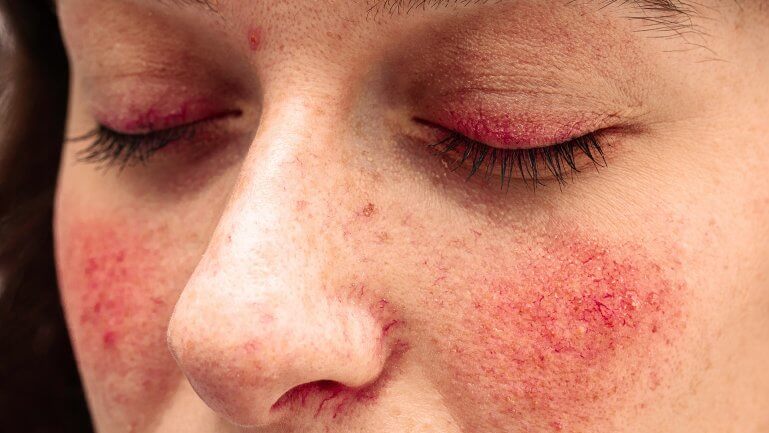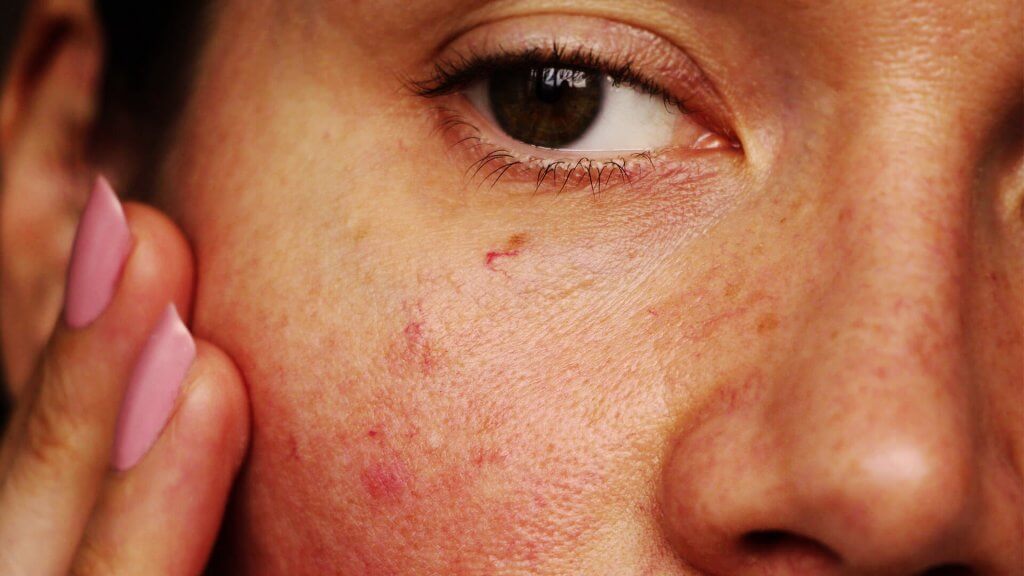Reduziere Rosacea
mit Sanubiom SkinCare Protect mit Phage Technology
Rosacea

The word rosacea comes from the Latin “rosaceus” and means “redness”, which already says a lot about the consequences of the inflammatory and frequently occurring skin disease. Rosacea leads to visible redness due to dilation of the blood vessels under the skin. The nose, cheek and forehead are most commonly affected. It can be recognized by large, red, scaly and sensitive areas and normally progresses in episodes.
But the eyes can also be affected and dry out.
If the eyes are also affected by the skin disease rosacea (rosacea), this is referred to as ocular rosacea. As either the skin, the eye or both can be affected, and eye rosacea can take different forms, it can easily be overlooked by the doctor or patient.
An attentive and trained eye is necessary to recognize rosacea on the eyes. Experience with the disease definitely helps with the diagnosis. The following symptoms occur individually or together on the eyes in rosacea:
To prevent permanent damage to your eyesight, it is advisable to consult a doctor if you experience one or more symptoms over a longer period of time.
With the help of a so-called slit lamp, the typical changes caused by rosacea on the eyes can be recognized and a suitable therapy can be developed.
There are two forms of rosacea on the eyes, the first is mild and even if the conjunctiva is irritated, the person’s vision does not deteriorate. Usually only one eye is affected first, then the second. There is a foreign body sensation combined with burning and pain. Since the second form of rosacea causes inflammation of the envelope of the eyeball and the central cornea, vision suffers greatly.
It is still unclear what exactly causes ocular rosacea. It could be caused by one or more factors such as genetic predisposition, psychological stress, environmental influences, bacterial superinfection, dysfunction of the Meiborn glands or demodex infestation (hair follicle mites) of the eyelashes.
There are several factors that can lead to the worsening of agenrosacea. These include alcohol. spicy food, too much and direct sunlight, wind or strong temperature fluctuations, but also physical exertion, hot baths or saunas.

It is still unclear what exactly causes ocular rosacea. It could be caused by one or more factors such as genetic predisposition, psychological stress, environmental influences, bacterial superinfection, dysfunction of the Meiborn glands or demodex infestation (hair follicle mites) of the eyelashes.
The first important step in treatment is the diagnosis of rosacea on the eyes and the prevention of rosacea triggers. Treatment can consist of many possible therapeutic approaches tailored to the individual patient. This includes, for example, cleaning the eyelids, administering antibiotics, using bacteriophages and administering moisturizing drops or tear substitutes.
In order not to promote the inflammatory processes that trigger rosacea, those affected should pay attention to their diet. Sugar, wheat, meat and cow’s milk should be completely avoided or reduced to a minimum. Pork and sausages in particular promote inflammation in the body. For people who are overweight, a reduction in body weight can have a positive effect on the disease.
A low-inflammatory diet consists of dishes with lots of vegetables and probiotics should be used to strengthen the immune system. These include in particular foods that contain lactic acid bacteria and yeasts, for example sauerkraut, yogurt and buttermilk.
You can find more information about nutrition and rosacea in our article here: Nutrition for rosacea
The skin should always be supplied with sufficient moisture to protect it from drying out. To allow the skin to breathe under the cream, you should use creams or lotions which, unlike ointments, have a higher water content. Lotions contain even more water than fat and are therefore also known as oil-in-water emulsions.
The face should be cleaned with lukewarm water. Care should be taken to avoid extreme water temperatures and rapid successive temperature changes in order to avoid sudden reddening of the skin.
Facial scrubs should also not be used for rosacea, as they can only irritate the skin even more. In addition, care and washing products without camphor, sodium laurysulphate, menthol and astringents should be used. The water should not have a high degree of hardness and the face should be gently dabbed with a towel after washing instead of rubbed dry.
You should also use water with a slightly acidic pH value.
The probiotic skin spray SkinCare Protect from Sanubiom promotes the growth of good bacteria. In addition, the phage technology it contains ensures that the bad bacteria are specifically eliminated.
This rebalances the skin, eliminates irritation and reduces redness.
SkinCare Protect uses Phage Technology to restore and maintain the skin’s natural balance.
Bacteriophages (e.g. Staphylococcus aureus phages) are used to contain the spread of specific bacteria (e.g. Staphlococcus aureus).
SkinCare Protect has therefore proven its worth as skin care for acne, rosacea and neurodermatitis and can be an alternative to medication.
SkinCare Protect also contains a specially developed nutrient medium that promotes the growth of good bacteria.
You can find more information on phage therapy at www.phage.help
Author: Christian Unterlechner, Dipl.-Ing. (FH), MBA
“From our own experience with neurodermatitis – and the long path of suffering associated with skin conditions like this – we started to look for alternative solutions to drug treatments. We are very happy to share the knowledge and experience that has gone into the years of developing our SkinCare products with you.”
Share post